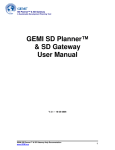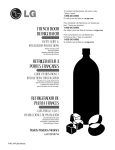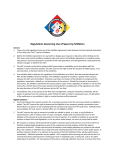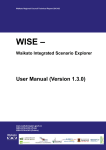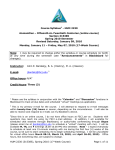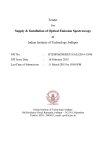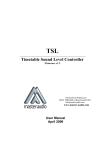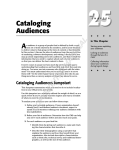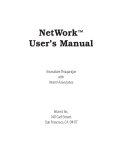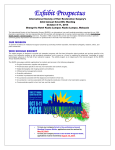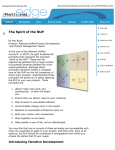Download GEMI SD Planner™ & SD Gateway User Manual
Transcript
SD Planner™ & SD Gateway A Sustainable Development Planning Tool GEMI SD Planner™ & SD Gateway User Manual V 3.1 – 08-01-2008 GEMI SD Planner™ & SD Gateway Help Documentation www.GEMI.org 1 SD Planner™ & SD Gateway A Sustainable Development Planning Tool Letter from the SD Planner™ Co-Chairs Dear Sustainability Partner: Exploring Pathways to a Sustainable Enterprise: The GEMI SD Planner™ and the SD Gateway is the result of a collaborative learning journey by members of GEMI. This software tool was created because we recognize the need and opportunity for business to address environmental, economic and social issues in a way that creates business value. The SD Planner™ is a detailed, comprehensive planning tool that you can use to establish baseline performance, assess opportunities, set goals, develop action plans and evaluate progress towards your sustainable development objectives. Use of this tool will assist you in identifying the critical sustainable development issues that are important to your business activities. The SD Planner™ is not a Code of Conduct for companies. It is not designed to suggest that companies should be actively engaged in all of the elements. It is a tool to be used internally within companies that recognize the importance of systematically considering environmental, economic development and social equity issues in a way that creates the most value for their business enterprise. GEMI recognizes that companies around the globe are just beginning their journeys toward sustainability and each company will determine its own approaches, concepts and actions to reach the goals that they have set for themselves. The journeys that will be undertaken by companies have many possible paths. There is not a single path that will meet the needs of a world that is constantly changing. This SD Planner™ User Guide is designed to help you understand how to use the software. It explores the context of why companies should care about sustainable development and then guides you on how to use the software to address the elements of sustainable development broadly throughout your organization and plan how to take action. All companies that are making commitments to sustainable enterprises are also exploring how to address the daily internal and external challenges that you will face. The words "sustainable development" are used frequently, but it is your actions that will help build the foundations for your company to grow and prosper. We hope that you will take the time to learn how to use and apply SD Planner™ in a way that makes sense for your organization. GEMI's goal is to develop tools in a way that "business helps business" make the planet that we all share a better place. The members of GEMI who developed this tool share it with you and hope that it will be a guide for you that you will share with others. Keith Miller Ted Reichelt 3M Intel Co-Chairs of GEMI's Sustainable Development Work Group GEMI SD Planner™ & SD Gateway Help Documentation www.GEMI.org 2 SD Planner™ & SD Gateway A Sustainable Development Planning Tool Table of Contents: LETTER FROM THE SD PLANNER™ CO-CHAIRS ........................................................................... 2 TABLE OF CONTENTS:............................................................................................................................ 3 1. INTRODUCTION .................................................................................................................................... 4 1.1.THE EMERGENCE OF SUSTAINABLE DEVELOPMENT ................................................................... 4 1.2. PURPOSE OF SD PLANNER™................................................................................................ 10 1.3. ELEMENTS OF SUSTAINABLE DEVELOPMENT .......................................................................... 11 1.4. PATHWAY TOWARD ACHIEVING SUSTAINABLE DEVELOPMENT ................................................. 13 2. USER GUIDE ......................................................................................................................................... 15 2.1.GETTING STARTED ................................................................................................................ 15 2.2 INSTALLING & OPERATING THE TOOL....................................................................................... 17 2.3. OVERVIEW OF GRAPHICAL USER INTERFACE .......................................................................... 24 2.3.SCREENING ........................................................................................................................... 25 2.4.SELF-EVALUATION ................................................................................................................. 26 2.5. GOAL-SETTING ..................................................................................................................... 29 2.6. GAP ANALYSIS...................................................................................................................... 30 2.7. ACTION PLANNING ................................................................................................................ 33 2.8 CASE .................................................................................................................................... 35 2.9. CUSTOMIZATION OF PLANNER ............................................................................................... 40 3.0 ADD COLLABORATIVE USERS: ................................................................................................ 45 ADD NEW USER: ......................................................................................................................... 45 APPENDIX I: DEFINITIONS OF SUB-ELEMENTS............................................................................ 48 SOCIAL: ...................................................................................................................................... 48 ECONOMIC: ................................................................................................................................. 50 ENVIRONMENTAL ......................................................................................................................... 50 GLOBAL ENVIRONMENTAL MANAGEMENT INITIATIVE LICENSE AGREEMENT............ 52 GEMI SD Planner™ & SD Gateway Help Documentation www.GEMI.org 3 SD Planner™ & SD Gateway A Sustainable Development Planning Tool 1. Introduction 1.1.The Emergence of Sustainable Development Overview of the Concept During the last decade, sustainable development (SD) has evolved from an esoteric concept to a key principle embraced by a number of corporations, government agencies, and non-governmental organizations (NGOs).The Bruntland Commission introduced the concept of SD in 1987, and offered the following definition: …[D]evelopment … that …meets the needs of the present without compromising the ability of future generations to meet their own needs.1 This definition suggests a vision of business enterprises that considers the balance of needs between present and future generations. Since then, SD has been interpreted to cover virtually all aspects of corporate approaches to economic development, environmental protection and social responsibility. Companies have adopted a variety of phrasings, including terms such as corporate responsibility, sustainable growth, and global corporate citizenship, to capture the essence of their own journeys towards achieving SD goals. Reflecting this evolution, another definition of SD has emerged that is seen by some as more aspirational and results oriented than the Bruntland definition: Sustainable development is about ensuring a better quality of life for everyone, now and for generations to come. There are a number of issues associated with SD that present significant challenges to the continued growth of global industries, particularly in developing nations. These issues include: • Environmental concerns, such as the potential for climate change due to CO2 and other global warming gases; degradation of air, water, and land in industrialized areas; depletion of natural resources, including fresh water, biomass, and minerals; loss of agricultural land due to deforestation and soil erosion; and threatened wildlife habitats, including forests, reefs, and wetlands.2 • Human health concerns, such as widespread exposures to trace levels of persistent, bioaccumulative, and toxic substances; the lack of potable water for approximately 1.5 billion people globally; unsanitary urban conditions (over 2 billion people lack access to sewers); and proliferation of both viral and bacterial infectious diseases.3 1 World Commission on Environment and Development.1987.Our Common Future. Oxford: Oxford University Press. 2 World Bank. World Development Indicators 2001 .2001.Washington, DC: World Bank. 3 Ibid. GEMI SD Planner™ & SD Gateway Help Documentation www.GEMI.org 4 SD Planner™ & SD Gateway A Sustainable Development Planning Tool Socio-economic concerns, such as increasing resource needs due to population growth; social disintegration resulting from displacement of traditional lifestyles; growing income gaps between rich and poor strata of society; lack of primary education for approximately 130 million children world wide; and extreme poverty –about 3 billion people, or roughly half the world’s population, are estimated to earn less than $2/day.4 Historically, most of these issues have appeared remote from the comfortable perspective of the more affluent nations. However, thanks to the revolution in modern telecommunications, the globalization of markets, and the rapid growth of developing economies, SD issues are globally communicated and can no longer be easily ignored. Today there is growing support around the world for public policy measures to promote SD. For example, the United Kingdom recently enacted an energy tax (known as the Climate Change Levy) that penalizes industrial firms if they do not achieve certain levels of energy efficiency. In addition to imposing regulatory requirements, governments are establishing waste reduction targets, promoting “cleaner” production methods, and supporting research and development into environmentally sound technologies. Moreover, increasingly broad segments of society are coming to expect companies to perform to higher standards of social responsibility and making their expectations known in ways calculated to capture the attention of companies. There have been boycotts of goods manufactured in ways thought of as socially irresponsible, a flow of investment capital to funds consisting of companies selected on the basis of exhibiting socially responsible behavior, and use of tools such as shareholder resolutions aimed at promoting greater corporate responsibility. At the same time, apart from any government mandates or incentives, there has been a quiet revolution in industry attitudes toward SD issues –from treating SD as an esoteric emerging issue, to treating it as an important element of business strategy and source of business value. Companies have found that SD can deliver both bottom line business value in the form of reduced operating cost and increased resource efficiency,5 and top line business value6 in the form of new market opportunities that lead to increased revenues and market share growth.7 4 Ibid. Global Environmental Management Initiative (GEMI). Environment: Value to Business.1998. Washington, DC: GEMI. 6 GEMI. Environment:Value to the Top Line.2001.Washington, DC:GEMI. 7 Poltorzycki, Stephen.1998. Creating Environmental Business Value: Achieving Two Shades of Green. Crisp Publications. 5 GEMI SD Planner™ & SD Gateway Help Documentation www.GEMI.org 5 SD Planner™ & SD Gateway A Sustainable Development Planning Tool The Response of the Business Community SD can be seen as a logical outgrowth of evolving industry practices, including environmental stewardship, pollution prevention, waste minimization, and design for environment methods, which seek to replace “end-of-pipe ” pollution control with more cost-effective process improvements. However, there are two important differences that distinguish SD from historical environmental management practices: • Introduction of the socio-economic dimension, focusing upon the beneficial or adverse impacts of corporate practices upon societal well-being • Recognition of the linkages between SD and competitive advantage in the marketplace, which elevates these issues to a strategic level. Faced with rising stakeholder concerns, the business community has recognized that long-term success depends not only on financial performance, but also on social and environmental performance. Today, we can define a “sustainable business” as one that is able to anticipate and meet the needs of present and future generations of customers and stakeholders.8 Sustainable businesses generally distinguish three dimensions of needs, known as the “triple bottom line”:9 • Economic prosperity and continuity for the business and its stakeholders • Social well-being and equity for both employees and affected communities • Environmental protection and resource conservation, both local and global. From this perspective, corporate SD is not just altruism – rather, it is an enlightened response to emerging market forces. Instead of merely listening to the voice of the individual customer, companies are beginning to listen to the collective voice of the larger Customer; namely, human society. Public awareness of the impact that companies can have on society and the environment gives rise to an expectation that companies will do business in a socially and environmentally responsible manner. This landscape creates opportunities for companies who can address these changing stakeholder expectations with new technologies, products, and services, thereby gaining competitive advantage. There are several underlying factors that help to explain the blossoming of business interest in SD. These include: 8 Fiksel, Joseph and Diane G.Fiksel.2001.From Here to Sustainability: A Global Perspective. Chemistry Business, April 2001. 9 st Elkington, John.1997. Cannibals with Forks: The Triple Bottom Line of 21 Century Business. Oxford: Capstone Publishing Limited. GEMI SD Planner™ & SD Gateway Help Documentation www.GEMI.org 6 SD Planner™ & SD Gateway A Sustainable Development Planning Tool • Growing evidence that companies can create shareholder value by moving beyond passive compliance and adopting eco-efficient design and production methods, resulting in improved operating efficiency and market positioning. • Increasing acceptance among top executives of the ethical obligations associated with “corporate citizenship,” and resulting attention toward constructive engagement and dialogue with external stakeholders. • Competitive pressures as more companies, especially historically well managed and progressive companies, adopt SD strategies, openly report on progress, and require improved performance by suppliers. • Emergence of doctrines such as “extended producer responsibility” which broaden the boundaries of corporate accountability and raise public expectations regarding company principles and operating practices. • Explosive growth of electronic communication, creating global accountability and transparency for companies that do business in developing nations. • Investigation by segments of the financial community of the concept that companies managed for sustainable growth tend to generate superior economic returns, leading to the rise of pooled investment vehicles and “socially-responsible” investing. Sustainable Business Practices In recent years, a number of leading multinational corporations in a variety of different industries have established highly visible SD programs. Rather than following a prescribed approach, each company has explored how it can integrate SD into its own business strategy. In general, the common purpose of these programs has been to shift the company operations from a traditional, resource-intensive, and volume-maximizing business model to a more eco-efficient, socially responsible, and value-maximizing model. This shift aligns nicely with the financial goal of increasing shareholder value by raising profits while reducing the use of capital and resources –i.e., doing more with less. Typically, there are several levels of sustainable business practices, with each succeeding level requiring a more sophisticated management response than the preceding level. The most basic level involves corporate initiatives such as philanthropic programs aimed at solving community social problems. The next level often involves reducing the “ecological footprint” associated with the product life cycle, including manufacturing, use, and end-of-life disposition. The most challenging level involves enhancing the inherent social value created by the firm’s operations, products and services, which may range from assuring human health and nutrition to stimulating consumer education and growth of new businesses. At this level challenging trade-offs may arise – for example, balancing job creation and economic development against community concerns about industrial pollution and environmental justice. One of the greatest pitfalls of SD is viewing it as merely a regulatory compliance issue, and addressing it through typical environmental, health and safety programs. Companies that are successful SD practitioners typically view SD as a strategic issue, have the GEMI SD Planner™ & SD Gateway Help Documentation www.GEMI.org 7 SD Planner™ & SD Gateway A Sustainable Development Planning Tool Chief Executive Officer or other senior executives as champions, and encourage crossfunctional collaboration throughout the organization in pursuit of innovative products and business models. Moreover, most practitioners agree that for SD to become truly integrated into business decisions, a systematic SD performance measurement process is essential. The SD Journey In the journey towards integration of SD into business strategy and practices, companies have different starting points and different objectives. However, the process by which they undertake the journey typically involves a series of steps that are similar from company to company. Companies often consider the following steps (also depicted in Figure 1) as they move from awareness of SD toward adoption and integration of SD into business practices: • Setting Context. A company first deals with understanding the context of SD. It seeks to address questions such as: What does SD mean for our industry? What does it mean for our company? What is the business case for action? • Establishing Direction. Next, the company sets a direction, or strategy that is appropriate for its business. There is no universal strategy for SD that works for all companies. The best strategy for a company will likely build on strengths already in place, including company values, organizational culture, technologies, core competencies, customer relationships, and the like. • Selecting Actions. The next step is to choose the specific actions that best realize the strategy. These actions will likely be geared towards the core competencies of the company or areas with the greatest potential to create business value, which could range from achieving operational ecoefficiency to product innovation to strengthening stakeholder relationships. These actions will also involve the process of engaging with stakeholders regarding SD issues: conducting open dialogue with them, responding to their concerns, and communicating with them in a transparent manner regarding the company’s activities. • Achieving Results. Once a set of action initiatives is launched to pursue SD, it is important that the results of these actions be captured, preferably in terms of measurable benefits to the corporation and society. These success stories will form the basis for establishing continued momentum in future SD efforts. • Organizational Alignment. After an initial period during which SD has been introduced and successful actions have been demonstrated, a broader program of communication and alignment is needed to assure that an understanding of SD is permeated throughout the organization. • Continuous Learning. Like any management process, SD requires a continuous improvement philosophy – learning from past experience and from both internal and GEMI SD Planner™ & SD Gateway Help Documentation www.GEMI.org 8 SD Planner™ & SD Gateway A Sustainable Development Planning Tool external dialogue adapting the company’s SD goals and direction to changing business conditions and societal expectations, and striving for ongoing innovation and growth. Figure 1.Steps on the SD Journey GEMI SD Planner™ & SD Gateway Help Documentation www.GEMI.org 9 SD Planner™ & SD Gateway A Sustainable Development Planning Tool 1.2. Purpose of SD Planner™ Embarking on the Journey There is no clear point of entry for getting started in SD – this is evident from the experiences of early adopters. In fact, the broad scope and complexity of SD present a puzzle for many companies. While most companies readily support the values represented by SD, they are not certain what initial actions, if any, should be launched. SD can seem boundless, with its long time horizon, breadth of scope ranging from social equity to resource security to biological diversity to economic development, and stakes as high as the survival of the species. SD Planner™ is intended to help companies understand the context of SD, provide a basis for developing a SD strategy, highlight opportunities to create business value, and provide a roadmap for taking action. It recognizes that each company will take the actions that are most suitable for its needs, but that the processes used by most companies in determining their strategies and actions may be similar to the processes used by other companies. SD Planner™ provides assistance to companies making this journey by setting forth guidance for the different steps of the journey. GEMI’s objective is that SD Planner™ will be a catalyst for making progress in SD, much like the GEMI ESAP tool10 was a catalyst for environmental management progress and the Responsible Care® self-assessment tool was a catalyst for environmental, health, and safety progress in the chemical industry. The overall objective of the tool is to help companies begin to integrate SD into their business processes. Although there is a significant self-assessment component to SD Planner™, it is intended as a means for companies to identify and help achieve SD goals, rather than as a way for companies to compare themselves to others. Capabilities of SD Planner™ There are a number of specific capabilities that SD Planner™ provides to help companies get started on their journey toward SD. • Establish generic elements of sustainable business practices. The tool synthesizes a broad range of generally accepted SD concepts into seven major elements. (See Figure 2.) This provides a comprehensive basis for companies to select the desired scope and focus of their own SD efforts. • Enable company assessment of current status. The tool provides a straightforward, structured approach toward assessment of a company’s current status relative to broad industry norms. For each element, a company can assess its position relative to a five- 10 GEMI.1994.Environmental Self-Assessment Program .Washington, DC: GEMI. GEMI SD Planner™ & SD Gateway Help Documentation www.GEMI.org 10 SD Planner™ & SD Gateway A Sustainable Development Planning Tool stage model of evolution. This will help companies to set context and formulate their SD goals. • Enable formulation of SD goals and gap analysis. The tool provides a flexible means for establishing company-specific goals with regard to any of the major SD elements. It also enables the identification of gaps between the company’s current and desired position, which provides the basis for developing action plans. Clarify the potential business value of SD. Depending on the chosen emphasis, the tool will help companies to understand the potential value associated with particular SD initiatives and thence formulate a business case for action. These insights are enriched by examples drawn from the experiences of GEMI member companies. • Provide guidance and support development of an action plan .For each selected element of SD, the tool assists companies in developing an agenda for action, by recommending appropriate actions that can help to achieve the company’s goals. Again, these recommendations draw upon the experiences of GEMI member companies. The intent of SD Planner™ is to provide the above capabilities in a manner that is generic, yet highly customizable to the needs of an individual company. In addition, SD Planner™ strives for clarity and simplicity, so that it is intuitive and easy to use with minimal training. The graphical user interface has been designed accordingly. It should be noted however, that the SD Planner™ has some important limitations. It is designed to help companies get started in establishing goals and action plans, but it does not attempt to support decision-making about what course of action is best. There are many trade-offs involved in balancing the expectations of stakeholders against the business objectives and constraints of a particular company. Similarly, there are many potential synergies available in pursuing multiple SD objectives that create “win-win” solutions for both the company and its stakeholders. 1.3. Elements of Sustainable Development SD Planner™ is based upon the premise that SD involves several elements, often referred to as the “triple bottom line.” There is a social aspect of SD that involves contributing to employee well-being, improving social well-being and quality of life, and engaging in business ethically. There is also an economic aspect of SD that involves creating shareholder value and building capacity for economic development. And there is an environmental aspect to SD that involves minimizing environmental impact and protecting natural resources. Figure 2 sets forth definitions of these elements, and the Appendix sets forth definitions of the sub-elements that are the components of the elements. It is clear that there are significant interrelationships between the several elements of SD, and that they should be thought of in an integrated manner. However, GEMI SD Planner™ & SD Gateway Help Documentation www.GEMI.org 11 SD Planner™ & SD Gateway A Sustainable Development Planning Tool for maximum ease of use, this initial version of SD Planner™ treats each of the elements independently. Figure 2.Sustainable Development Element Definitions GEMI SD Planner™ & SD Gateway Help Documentation www.GEMI.org 12 SD Planner™ & SD Gateway A Sustainable Development Planning Tool 1.4. Pathway Toward Achieving Sustainable Development SD Planner™ lays out a number of stages that companies may take in moving towards their SD goals. Although these stages are intended to represent increasingly sophisticated approaches, it does not follow that companies should necessarily strive for the “highest” stage. Companies need to determine which stage will deliver the most business value at a given time. The characteristics of how companies within each stage approach SD can be summarized as follows: I. Prepare: Minimize SD efforts, while assessing the issue, what other companies are doing, and potential opportunities. II. Commit: Commit to moving forward in addressing SD and chose a strategic direction for their SD actions. III. Implement: Launch programs consistent with their SD strategy. IV. Integrate: Make SD part of every day business processes. V. Champion: Act as a leader and champion for others within industry to act on SD. Figure 3 summarizes some of the key aspects of each stage of the SD pathway. GEMI SD Planner™ & SD Gateway Help Documentation www.GEMI.org 13 SD Planner™ & SD Gateway A Sustainable Development Planning Tool Figure 3: SD Pathway Stages. GEMI SD Planner™ & SD Gateway Help Documentation www.GEMI.org 14 SD Planner™ & SD Gateway A Sustainable Development Planning Tool 2. User Guide 2.1.Getting Started Who should use SD Planner™? SD Planner™ is designed for use by a variety of different groups within a company. It is optimized for use by a business unit, but it can also be used by a corporate group on behalf of the company as a whole. Typically, a functional group will assume a lead role for applying the tool, and a specific individual or team will be responsible for actually entering information and generating results. However, because of the broad scope of the tool, it is likely that this team will need to interface with representatives from several functional areas, potentially including strategic planning, marketing, communications, human resources, operations, distribution, research and development, finance, and environmental, health and safety. The team will also need to define the organizational scope of SD Planner™’s application (e.g., wholly owned subsidiaries, partially owned subsidiaries, joint ventures, contractors, investments). Depending upon the composition of the team and the functional groups that need to contribute, there are several possible methods of application: • A primary information gatherer can be assigned to collect all of the responses necessary to complete the diagnostic and assessment portions of SD Planner™. This can be accomplished through a series of interviews with functional specialists. • The primary user can generate paper copies of the assessment forms for the various SD elements, distribute these to appropriate specialists along with relevant guidance, and then compile the results. • The primary user can invite the required specialists to complete the assessments electronically. This should be done on a single hardware platform, since SD Planner™ does not support integration of distributed data from multiple sources. Overall architecture and functionality The architecture of SD Planner™is based on a simple five-step planning process, depicted in Figure 4.These five steps correspond to the three major activities that the tool supports: • Screening. This step is the starting point for any application, and enables you to identify your company context, key issues, and initial focus. This information will influence SD Planner™’s recommendations regarding potential goals and actions. • Assessment. The assessment activity is the heart of the tool, and consists of three steps that can be performed iteratively: GEMI SD Planner™ & SD Gateway Help Documentation www.GEMI.org 15 SD Planner™ & SD Gateway A Sustainable Development Planning Tool - Self-Evaluation enables you to apply a set of assessment templates that characterize your company’s SD status for specified elements. - Goal-Setting enables you to set goals for specified SD elements. - Gap Analysis enables you, at any point during the assessment, to compare status against goals for specified SD elements, and thus identify gaps. •Action Planning. This step proposes actions that will address the gaps identified above, and enables you to print action planning reports for specified SD elements. Context-specific guidance is available at all times to help define and illustrate the SD concepts being presented. SD Planner™ is extremely flexible, so that you can work on the above steps for selected SD elements in any order, and can save partially completed assessments for later revision and updating. Figure 4. SD Planner™ Architecture Most likely, SD Planner™ will be used over an extended period of time, involving multiple sessions of information gathering, assessment, revision, planning, and updating. For companies that embark upon an SD program, it can serve as an ongoing repository of status information to support tracking of progress. In addition, the graphical nature of SD Planner™ allows it to be used not only for assessment and planning purposes, but also to support status briefings to management, dialogues with internal and external stakeholders, and development of communication materials. GEMI SD Planner™ & SD Gateway Help Documentation www.GEMI.org 16 SD Planner™ & SD Gateway A Sustainable Development Planning Tool 2.2 Installing & Operating the tool The GEMI SD Planner™ is a web-based tool, and needs to be run on a Web server that supports the following requirements: • PHP programming language • mySQL database Important Note: The GEMI SD Planner™ is designed to run on a web-server. It is not designed to run on a laptop or desktop computer. To install the application you should follow the installation instructions below: 1. Upload the files to a web server via FTP. • • • For best results, upload to a web server that is available via the web using a domain name. For example, www.gemi.org is the domain name and /sd is the folder where the demonstration version of this software is located: www.gemi.org/sd You can upload this onto an intranet, but only people with access to the intranet will be able to use the system. This software is not designed to run on a laptop or desktop computer. 2. Change the file permissions of the include directory to 777. 3. Change the file permissions of this file: include/configuration.php to 777. 4. Create a blank mySQL database. 5. Enter your database information using the form located in the /install/ directory. Installation Setup Screen: GEMI SD Planner™ & SD Gateway Help Documentation www.GEMI.org 17 SD Planner™ & SD Gateway A Sustainable Development Planning Tool 6. Remove the writable permissions from the include directory after successful installation. 7. Log into the admin area in the /admin/ directory with the username and password that you specified in the installation process. 8. Create a new company or division in the admin area. Add New Company Screen: Paid Tech Support: • • • Need help installing the software? Need a place to install the GEMI SD Planner software? Need training to learn how to use the sustainable development planning tool? Visit www.CustomerParadigm.com/sd/ or call 303.473.4400 x11. Note: This is not a specific endorsement by GEMI for this organization, but is provided as a helpful resource for those needing help with their sustainable development planning process. GEMI SD Planner™ & SD Gateway Help Documentation www.GEMI.org 18 SD Planner™ & SD Gateway A Sustainable Development Planning Tool Administrator Area of the Site: In the admin area of the site, you have the following options: Add New Company: • • • • • Allows you to add a new company, business division or business unit to the SD Planner. All information for the new company is kept separate – so Company A’s information will not be mixed with Company B’s information. Login Info: o The username and password for the main user for this company. This user will be able to create other collaboration users, and will have access to all of the company information in the SD Planner™ for the particular company. Personal Information: o The contact name, email, designation and photo of the person who is the company-level manager. This information is used to personalize the SD Planner™ and SD Gateway. Company Info: o Company Name, Address, Phone Number, Fax and Logo and company information. o This information is used to personalize the SD Planner™ and SD Gateway. GEMI SD Planner™ & SD Gateway Help Documentation www.GEMI.org 19 SD Planner™ & SD Gateway A Sustainable Development Planning Tool • Set Threshold: o Each company can have their own threshold for the SD planning process. o The threshold should be a number between 1% and 100%. o The threshold level for satisfaction of goals is established by the user. (See Section 2.9.) The purpose of this threshold is to provide flexibility in the self-evaluation process. It may be that your organization has implemented most of the practices associated with a given stage and is ready to move forward, even though a few gaps remain. SD Planner™ allows you to define goal satisfaction in terms of the percentage of practices implemented. A threshold of 100% means that you cannot complete a given Stage until all the associated practices are implemented. Alternatively, the threshold can be set as low as 50%. Modify Company: • Allows you to edit an existing company, business division or business unit in the SD Planner. Gateway Information Settings: • • • • • Allows you to globally add or remove Gateway Information that will be displayed to the users of each company. This is ideal for displaying RSS Newsfeeds, content, an image, or a list of links to all people within an organization. All users for this installation (company users, collaboration users) will see the Gateway Information that you specify here. To Add a new box, click on the link ‘Add New Info Box.’ To Edit or Delete an existing box, click on Edit or Delete next to each box. SD Gateway Admin Area: GEMI SD Planner™ & SD Gateway Help Documentation www.GEMI.org 20 SD Planner™ & SD Gateway A Sustainable Development Planning Tool To Add an Information Box to the SD Gateway, please choose a title, and then select from the following options: • RSS Feed Box: o Enter in the website URL of the RSS feed that you want the system to display. o The number of RSS feeds allows you to have the system display a selected amount of links. If this field is set to 4, for example, only four news articles will be displayed. If the field is set to 8, the system will display the top eight news feed articles. • Image Box: o You can use this box to upload an image (400 pixels by 400 pixels) that will be displayed to users in the SD Gateway area. • Content Box: o You can use this box to display a short content article to users in the SD Gateway area. GEMI SD Planner™ & SD Gateway Help Documentation www.GEMI.org 21 SD Planner™ & SD Gateway A Sustainable Development Planning Tool • Gateway Link Box: o In the left column, type in the link that you wish people to be able to visit. Links should be formatted with the http://www.gemi.org/ format. You can usually copy and paste this information from the address bar of your browser. o In the right column, under ‘Short Description’, type a short description of the link. o For example, a link description might be GEMI Home Page. Manage Elements, Stages, Practices & Cells: In these areas of the admin tool, you can add new elements and edit or delete existing information. You will be able to modify the existing information that is standard when new companies are added into the system. Please note that any changes that you make to these areas will not affect current companies that have already been added to the system, but only when a new company is added. To modify an existing company, please log into the system as a company user and modify the desired elements. GEMI SD Planner™ & SD Gateway Help Documentation www.GEMI.org 22 SD Planner™ & SD Gateway A Sustainable Development Planning Tool If you add new elements or items into the SD Planner, each new item will have a red dot next to it, allowing you to know that this has been modified from the original SD Planner information. Help Pages: The help pages of the system are able to be edited by the administrator. If you find that the directions on how to use the system need a bit of extra emphasis for your organization, you can edit the content using an online HTML editor. You can insert graphics and images, and create links through this interface. GEMI SD Planner™ & SD Gateway Help Documentation www.GEMI.org 23 SD Planner™ & SD Gateway A Sustainable Development Planning Tool 2.3. Overview of Graphical User Interface The SD Planner™ and SD Gateway was designed to be simple and intuitive, so that use of extensive documentation would not be necessary. The graphical user interface is essentially a series of forms, where you enter data and issue commands. This User Guide is intended to orient beginning users by familiarizing them with the basic graphical elements and functionality of the tool. After the first few sessions, a user should not need to refer to this document. All of the guidance presented here is also accessible via the Help buttons located on each screen of SD Planner™. All of the SD Planner™ functions are launched from the left-hand navigational menu, shown at left. This SD Planner menu has buttons that launch each of the five steps described in Section 2.1: 1.Screening 2.Self-Evaluation 3.Goal-Setting 4.Gap Analysis 5.Action Planning SD Planner™ Wizard: Home: This button brings the user back to the SD Planner™ and SD Gateway home page. User Guide: The User Guide button launches this document, in the Acrobat ® Reader ® format. Planner Wizard: On the home page, there is a simple wizard that allows users to progress through the steps of the Planner in a step wise order. Updates: The highlighted message on the homepage will let the user know if a new version of the SD Planner™ is available for download. GEMI SD Planner™ & SD Gateway Help Documentation www.GEMI.org 24 SD Planner™ & SD Gateway A Sustainable Development Planning Tool 2.3.Screening The Screening window requests several items of information regarding characteristics of your company or business unit. Issues that you rank as high in importance on this screen, such as “stakeholder scrutiny,” are used later to suggest goals (see Section 2.5) or action priorities (see Section 2.7). For most questions, simply select a button from the choices provided. For Question 3, you are asked to rank order your strategic priorities by clicking on the arrow next to the number displayed. Note that all of your selections are saved in the database. At any time, you can return to this page to change the selections. To the right of each question is a Comment field. You can enter brief comments explaining the rationale for the selection made. GEMI SD Planner™ & SD Gateway Help Documentation www.GEMI.org 25 SD Planner™ & SD Gateway A Sustainable Development Planning Tool 2.4.Self-Evaluation The Self-Evaluation window is used to assess the current status of your company or business unit relative to the elements defined in SD Planner™. This information is used subsequently to determine whether the organization is meeting its stated goals and to recommend potential actions. On this page, you can view any of the seven elements in the form of a matrix. The columns correspond to business practices in the five progressive stages of SD. The rows, or sub-elements correspond to the different issues that are included in each element. To assign a rating, simply click in on one of the dots (blue, green, or empty circle), and a pop-up window will appear that allows you to make a choice: GEMI SD Planner™ & SD Gateway Help Documentation www.GEMI.org 26 SD Planner™ & SD Gateway A Sustainable Development Planning Tool Definition: The definition of the element is provided at the top, and you can change the value to the desired outcome. Value: Change the value using the drop-down menu. • Yes: indicates that the practice is implemented • Not Selected: indicates that the practice is not implemented • Not Selected: (i.e., blank) indicates that the practice has not yet been rated. The legend is as follows: Comments: Use the comments field to enter comments about this element. Case Stories: You can read applicable case of company experiences that exemplify the relevant practices. You are not able to modify or edit the case stories. GEMI SD Planner™ & SD Gateway Help Documentation www.GEMI.org 27 SD Planner™ & SD Gateway A Sustainable Development Planning Tool There is no requirement to proceed in any particular order. However, it is recommended that you proceed element by element, moving from left to right through the stages. In addition, the left hand navigation buttons allow you to move through the elements consecutively. Threshold: The threshold level for satisfaction of goals is established by the admin user of the company. (See Section 2.9.) The purpose of this threshold is to provide flexibility in the self-evaluation process. It may be that your organization has implemented most of the practices associated with a given stage and is ready to move forward, even though a few gaps remain. SD Planner™ allows you to define goal satisfaction in terms of the percentage of practices implemented. A threshold of 100% means that you cannot complete a given Stage until all the associated practices are implemented. Alternatively, the threshold can be set as low as 50%. In general, increasing the threshold value will increase the stringency of assessment, and thus will tend to widen the gaps between goals and current practices. Your organization has completed a stage if the number of practices implemented in that stage exceeds the threshold. For example, in a chosen sub-element, if 3 of the 4 cells (i.e., 75%) in Stage 2 are green, and the threshold is 67%, then Stage 2 is considered completed. The current threshold value is always displayed at the bottom of the window. GEMI SD Planner™ & SD Gateway Help Documentation www.GEMI.org 28 SD Planner™ & SD Gateway A Sustainable Development Planning Tool 2.5. Goal-Setting The Goal-Setting window is used to establish specific performance goals relative to the elements defined in SD Planner™. This information can subsequently be compared to the self-evaluation results in order to determine whether the organization is meeting its stated goals and recommend appropriate actions. GEMI SD Planner™ & SD Gateway Help Documentation www.GEMI.org 29 SD Planner™ & SD Gateway A Sustainable Development Planning Tool This page is similar to the Self-Evaluation area, in that you view any of the seven elements in the form of a matrix. You can select your company or business unit goals by clicking in the appropriate stage for each sub-element. As in the Screening area, you can add comments to explain your rationale for each goal. The goals may vary depending upon company priorities. For example, as illustrated above, a company may review the sub-elements in light of its situation and needs, and decide to set the goal for Employee Rights at Stage 3, while setting the goal for Respect for Diversity at Stage 5. 2.6. Gap Analysis The Gap Analysis function is the heart of SD Planner™. It is used to compare goals against self-evaluation results. Whenever the organization's current practices fall short of the goals, a gap is said to exist. Gap analysis is initiated by clicking the corresponding button on the SD Planner lefthand navigation. This launches the Gap Analysis area. Select one of the following options and click the View button to display the result: • View by Element: compares current practices to goals for a selected element. • View by Category: is similar, but displays all elements within a category. • View Summary: shows a high-level summary of "average" status for all elements. GEMI SD Planner™ & SD Gateway Help Documentation www.GEMI.org 30 SD Planner™ & SD Gateway A Sustainable Development Planning Tool View by Element The display in this window is similar to the Self-Evaluation window, in that you can view any of the seven elements in the form of a matrix. For each sub-element, the display shows which stages have been satisfied as a orange bar, and the goal as a blue dot. View by Category This window is identical to the View by Element window, except that you view all of the elements in any one of the three categories –Social, Economic, Environmental. GEMI SD Planner™ & SD Gateway Help Documentation www.GEMI.org 31 SD Planner™ & SD Gateway A Sustainable Development Planning Tool View Summary This window shows a high-level summary of all seven elements (see below).The range of current practices completed for each element, based on self-evaluation results, is shown in the form of a green check mark, while the range of goals is shown by a blue circle. These icons indicate the variation between the lowest and highest ratings among sub-elements. Note: Averages can be deceptive, because one high score can skew the results significantly. To better understand the range of variation, use View by Element. GEMI SD Planner™ & SD Gateway Help Documentation www.GEMI.org 32 SD Planner™ & SD Gateway A Sustainable Development Planning Tool 2.7. Action Planning Finally, the Action Planning area of the Planner enables you to generate a customized list of proposed actions based on the identified gaps. It is expected that you will take this list and use it to generate ideas for an action plan that s appropriate for your organization. After you select the elements of interest, SD Planner™ can generate a set of proposed actions for every stage where a gap exists between goals and current practices. There are several different categories of actions that can be selected through the menu. First, select the element to be examined from the pull-down list at the top or in the bulleted list on the left. GEMI SD Planner™ & SD Gateway Help Documentation www.GEMI.org 33 SD Planner™ & SD Gateway A Sustainable Development Planning Tool Then, select the sub-element(s) to be examined from the list at the left. Finally, select the stages for which you would like to generate actions. The following options are provided: • All Stages generates a complete listing of all actions, regardless of gaps. • Advance by 1 Stage lists actions that would advance you to the next stage. • Advance to Meet Goals lists actions that would advance you as many stages as necessary to meet your goal, wherever applicable. • Advance to Stage 5 lists actions that would advance you to Stage 5. • Backfill Gaps is an additional option that can be toggled on or off for any of the above three cases. It lists not only actions that will advance you forward, but also actions that would fill any gaps that may remain due to the threshold being less than 100%. (See Threshold in Section 2.4.) After making your selections, click the View Report button to generate a report of all the relevant actions recommended: GEMI SD Planner™ & SD Gateway Help Documentation www.GEMI.org 34 SD Planner™ & SD Gateway A Sustainable Development Planning Tool The Action Reports for each Element consist of several columns (see example in Section 2.8): • Sub-element based on the selections made above • Stage based on the selections made above • Practice within each stage • Proposed Action Items associated with each practice • High Priority Factors (indicates that the practice corresponds to a #1 priority that was identified in the Screening step, e.g., Stakeholder Relationships). The following icons will help you print, export information and move back through the system: Printer Icon: Allows you to send this page directly to the printer, and removes the top, left and bottom navigation. Back Arrow: Allows you to go back one page in the system. Print-Screen: Hold down the Print Screen button on a PC, and you can then go to PowerPoint, Word, or another application and click ‘Paste.’ This will allow you to display the report in your document. 2.8 Case Studies View Case Examples View Case Examples allows you to view and sort all of the case examples that are in the system. On the Case Examples page you can: • • • • • • • • Search by Keyword for a specific Case Example Set the number of Case Examples that you want to view per page View subsequent pages of Case Examples Flag Case Examples that are of interest to you Sort the Case Example list by Ascending or Descending order based on the Subelement number Sort Case Name in alphabetical or reverse alphabetical order Sort Case Examples by Element Name View the number of comments for each Case Example GEMI SD Planner™ & SD Gateway Help Documentation www.GEMI.org 35 SD Planner™ & SD Gateway A Sustainable Development Planning Tool GEMI SD Planner™ & SD Gateway Help Documentation www.GEMI.org 36 SD Planner™ & SD Gateway A Sustainable Development Planning Tool Searching for Case Examples: The Search field allows you to search for a specific Case Example by entering in keywords: GEMI SD Planner™ & SD Gateway Help Documentation www.GEMI.org 37 SD Planner™ & SD Gateway A Sustainable Development Planning Tool View Case Example: By clicking on the underlined case name, you can view the entire case example. In this view, you can also print this case example for your records, view comments made about this case example, and add a comment to a specific case example. GEMI SD Planner™ & SD Gateway Help Documentation www.GEMI.org 38 SD Planner™ & SD Gateway A Sustainable Development Planning Tool Forwarding Case Examples to a Colleague: By clicking on the Forward Case Example to a Colleague link from the View Case Example page, you will be directed to this screen which will allow you to enter in the recipient’s email address and add a note to the recipient. The recipient will receive your note along with a copy of the case example in the email. Suggesting A Case Example: By clicking on the Suggest New Case Example link, you can make a suggestion regarding a case example that the company could add to the collective of case examples. GEMI SD Planner™ & SD Gateway Help Documentation www.GEMI.org 39 SD Planner™ & SD Gateway A Sustainable Development Planning Tool 2.9. Customization of Planner In the left-hand navigation of the site, you can add, edit and delete the elements, stages, practices and cells of the Planner. If an element, for example, has been changed, a red dot will indicate that it has been modified from the original GEMI SD Planner™ components. Edit Elements: In this view, the Employee Rights and Responsible Workplace Practices areas have been modified from the original GEMI data: GEMI SD Planner™ & SD Gateway Help Documentation www.GEMI.org 40 SD Planner™ & SD Gateway A Sustainable Development Planning Tool Edit Stages: You can edit the stages of the SD Planner™ to better align the states or definitions with your own organization’s naming conventions. You are also able to set the display order by changing the numbers in the boxes on the left: To edit the Prepare Stage, click on the ‘Edit’ button to the right of the name. The following screen will appear: GEMI SD Planner™ & SD Gateway Help Documentation www.GEMI.org 41 SD Planner™ & SD Gateway A Sustainable Development Planning Tool Edit Practices: You can view the practices, and edit each element view the edit practices screen. GEMI SD Planner™ & SD Gateway Help Documentation www.GEMI.org 42 SD Planner™ & SD Gateway A Sustainable Development Planning Tool You can then drill down to each item to view the definitions and/or edit them: Edit Cells: Finally, you can manage the specific cells in the system by using a series of drop-down menus to select the element, sub-element, stage, and practice: GEMI SD Planner™ & SD Gateway Help Documentation www.GEMI.org 43 SD Planner™ & SD Gateway A Sustainable Development Planning Tool On the edit cells page, you can edit the definition and action information: GEMI SD Planner™ & SD Gateway Help Documentation www.GEMI.org 44 SD Planner™ & SD Gateway A Sustainable Development Planning Tool 3.0 Add Collaborative Users: Adding new collaborative users to the system is easy. A company-level user can use the following menu: This screen can also be used to modify (edit) or delete existing users. The link listed in this menu is the link that collaborative users should use to login to the system. Add New User: From the Manage Users screen, click on ‘Add new User’. The following screen will ask for a username, password, and their first and last name and email address: GEMI SD Planner™ & SD Gateway Help Documentation www.GEMI.org 45 SD Planner™ & SD Gateway A Sustainable Development Planning Tool Next, choose the User Type. The user type allows you to choose if the user is able to add, edit or delete information in the system. The next section (see below) allows you to choose where you want this collaborative user to be able to read, edit or delete. • To create a read-only user, who will only be able to view information in the system, but can’t add, edit or delete anything, choose the first option. • A Read-Write user can edit selected areas of the system, but can’t delete items. • A Read-Write-Delete user can perform most functions, including editing and deleting. • A Company Admin User can add, edit and delete information, but is limited to specific areas in the Access Areas (see below). Next, select the appropriate Access Areas. To create a user with access to all areas of the system, click on the first checkbox. To select individual access areas, simply check the appropriate boxes next to each area. GEMI SD Planner™ & SD Gateway Help Documentation www.GEMI.org 46 SD Planner™ & SD Gateway A Sustainable Development Planning Tool For example, you may want to create a read-only user that has access only to the Gap Analysis and Action Planning areas (so that they cannot edit the elements, stages or practices). Database Maintenance The SD Planner™ tool does not require regular database maintenance. If the system is slow, it is usually due to a slow connection to the web server that is running the application. However, if you do encounter slow response or error messages, your system administrator can use the Compact and Repair Database command in the mySQL database system. GEMI SD Planner™ & SD Gateway Help Documentation www.GEMI.org 47 SD Planner™ & SD Gateway A Sustainable Development Planning Tool Appendix I: Definitions of Sub-Elements Social: Element 1: Employee Well-Being Protecting and preserving the fundamental rights of employees, promoting positive employee treatment, and contributing to employee quality of life. Sub-Element 1.1 – Employee Rights Respecting the rights of employees, including their right to associate, promoting diversity, and supporting constructive dialogue between employees and employer. Sub-Element 1.2 – Responsible Workplace Practices Promoting responsible workplace practices and positive employee treatment. This includes taking no part in compulsory (forced) labor, exploitation of children, corporal punishment, and physical abuse of employees. Sub-Element 1.3 – Employee Health and Safety Promoting a healthy and safe workplace. This includes compliance with occupational health and safety standards and practices, management of health and safety risks in the workplace, and employee training. Sub-Element 1.4 – Work Life Balance Promoting balance between work and personal or family life. Examples of programs and practices include flexible work options, dependent care services, time-off policies, or health and wellness programs. Sub-Element 1.5 – Respect for Diversity Promoting diversity as a source of innovation. Eliminating discrimination and harassment for any cause,e.g., color, race, gender, age, disability, ethnicity, sexual orientation or religion. Examples of programs or practices include equal opportunity programs, job training for disadvantaged groups, and fair employment practices. Sub-Element 1.6 – Employee Compensation Compensating employees fairly, without discrimination, and in a manner that enables them to meet at least their basic needs. Element 2: Quality of Life Working with public and private institutions to improve educational, cultural, and socioeconomic well-being in the communities in which the company operates and in society at large. GEMI SD Planner™ & SD Gateway Help Documentation www.GEMI.org 48 SD Planner™ & SD Gateway A Sustainable Development Planning Tool Sub-Element 2.1 –Social Equity Working to eliminate barriers to social equity, which could include contribution to the development of public policy, business, governmental and intergovernmental programs, and educational initiatives that promote a better quality of life. Note: For the purposes of this tool, social equity may be defined as fair and impartial access to social or public services regardless of economic or social status. Sub-Element 2.2 – Basic Human Needs Helping address basic human needs, such as healthcare, nutrition, education, housing, sanitation, clean water, transportation, and communication in the communities in which the company operates and in the society at large. This could include contributing to the development of social capital (the ability of people to work together in a society for a common purpose, based on a sense of mutual trust)and supporting programs that promote social infrastructure and the health and well-being of community residents. Sub-Element 2.3 –Human Capital Developing and preserving human capital by activities such as generation of employment and training opportunities and by responsibly addressing the support needs of displaced employees. Element 3: Business Ethics Supporting the protection of human rights within the company’s sphere of influence, and promoting honesty, integrity and fairness in all aspects of doing business. Sub-Element 3.1 – Basic Human Rights Protecting and upholding the basic human rights to which all people are entitled regardless of race, nationality, gender, economic status, or religion. Sub-Element 3.2 – Positive Impact Considering the full range of social, economic and environmental impacts on a community associated with company operations and ensuring that these impacts are, on balance, positive. Sub-Element 3.3 – Local Cultures and Indigenous People Respecting the integrity of local cultures and indigenous people. Indigenous people are the existing descendants of the original people inhabiting a particular region or country. Sub-Element 3.4 – Fair and Free Competition Engaging in fair and free competition, not offering, paying, or accepting bribes or kickbacks, and refraining from using information on competitors that was obtained illegally or unethically. GEMI SD Planner™ & SD Gateway Help Documentation www.GEMI.org 49 SD Planner™ & SD Gateway A Sustainable Development Planning Tool Economic: Element 4: Shareholder Value Creation Creating value for the company’s shareholders. Includes securing a competitive return on investment, protecting the company ’s assets, and enhancing the company ’s reputation and brand image through integration of sustainable development thinking into business practices. Sub-Element 4.1 – Competitive Return and Protection of Assets Applying professional and diligent management to secure competitive return on shareholders ’investment, and conserving, protecting, and increasing the company’s assets through integration of sustainable development thinking into business practices. Sub-Element 4.2 – Reputation and Brand Enhancing company reputation and brand image through integration of sustainable development thinking into business practices. Element 5: Economic Development Building capacity for economic development in the communities, regions and countries in which the company operates or would like to operate. Sub-Element 5.1 –Stimulating Local Development Supporting economic development by partnering with local businesses, hiring local staff and suppliers, and contributing capital to investment vehicles that benefit community business growth. Sub-Element 5.2 –Supporting Disadvantaged Communities Promoting the economic interests of lower-income and underserved communities by providing access to jobs, facilitating the transfer of knowledge and technology, and encouraging entrepreneurship. Environmental Element 6: Environmental Impact Minimization Minimizing and striving to eliminate the adverse environmental impacts and human health effects associated with operations, products, and services. Sub-Element 6.1 –Emissions and Wastes Minimizing adverse environmental impacts and human health effects associated with air emissions, wastewater discharges, offensive odors, excessive noise, and solid and hazardous waste generation associated with operations (including transportation and company vehicle use), products, and services. Includes efforts such as process GEMI SD Planner™ & SD Gateway Help Documentation www.GEMI.org 50 SD Planner™ & SD Gateway A Sustainable Development Planning Tool changes, equipment changes, material substitution, changes in handling practices, source reduction, recycling, and conversion to energy. Sub-Element 6.2 – Operational Incidents Minimizing or eliminating spills, releases, accidents, and other incidents with the potential for adversely impacting people or the environment. Sub-Element 6.3 – Products and Services Developing and distributing products and services whose adverse environmental impacts and effects on humans have been assessed and minimized. Considering how a new product or service can have a positive impact on the natural world. Includes understanding the environmental, health and safety impacts of products and services along the entire life cycle and taking steps to eliminate or reduce these impacts and risks from intended uses or reasonably foreseeable misuses. Also includes designing new products and processes with the intent of minimizing wastes, reducing emissions, and eliminating adverse end-of-life impacts. Element 7: Natural Resource Protection Promoting the sustainable use of renewable natural resources and conservation and sustainable use of non-renewable natural resources. Sub-Element 7.1 – Biological Resources Promoting the conservation and sustainable use of biological resources. Includes the protection and restoration of biodiversity, endangered species, and sensitive habitats such as forests, wetlands, coral reefs, and marine sanctuaries. Note: For the purposes of this tool, biodiversity (biological diversity) is the term used to describe the number, variety and variability of living organisms and includes genetic diversity and the ecosystems that support life. Sub-Element 7.2 – Energy Conserving energy and improving the energy efficiency of operations and of goods and services sold. Where practical, includes conserving and efficiently using fossil fuels and moving towards increased use of environmentally safe and sustainable energy sources. Sub-Element 7.3 – Water Conserving water and improving water quality through efficient use and careful planning. Includes improving the water efficiency of facilities, processes, and products and reducing or eliminating process and wastewater discharges. Sub-Element 7.4 – Raw Materials Helping conserve primary resources, such as minerals, timber, and agricultural products, by reducing raw material use in processes, packages, and products. Includes adopting efficient industrial processes related to the reuse and recycle of materials, such as metals, paper, plastics, and construction materials, and the consideration of how use of renewable resources can help conserve primary resources. GEMI SD Planner™ & SD Gateway Help Documentation www.GEMI.org 51 SD Planner™ & SD Gateway A Sustainable Development Planning Tool Global Environmental Management Initiative License Agreement GEMI and Licensee hereby agree, effective on Licensee’s opening of the Product, for good and sufficient consideration, as follows: 1. License Agreement. As used in this Agreement, “GEMI” shall mean Global Environmental Management Initiative. “Licensee” shall mean the user of this Product who opens this Product. The “Product” shall mean a software application called “SD Planner™” that is implemented using Microsoft ® Access 2000, and helps companies in assessing and planning their sustainable development practices. GEMI grants Licensee a non-exclusive and non-transferable license to use for internal business purposes the executable code version of the Product, until such time as this License is terminated by GEMI. This license does not entitle Licensee to receive from GEMI hard-copy documentation, technical or customer support, telephone assistance, or enhancements or updates to the Product. GEMI may terminate this Agreement at any time, for any reason or no reason. Upon termination, Licensee shall destroy all copies of the Product. 2. Restrictions. Without GEMI’s prior written consent, and except as permitted by the Product’s “Customize SD Planner” function, Licensee may not: (i) modify or create any derivative works of the Product or documentation, including customization, translation or localization; (ii)decompile, disassemble, reverse engineer, or otherwise attempt to derive the source code for the Product; (iii) redistribute, encumber, sell, rent, lease, assign, sublicense, or otherwise transfer rights to the Product; or (iv) remove or alter any trademark, logo, copyright or other proprietary notices, legends, symbols or labels in the Product. 3. Fees. There is no license fee for use of the Product by Licensee. 4. Proprietary Rights. All title, ownership rights, and intellectual property rights (trademark, copyright and otherwise) in the Product shall remain in GEMI or as specified in GEMI’s ownership agreements for the Product. The Product is protected by copyright and other intellectual property laws and by international treaties. Licensee expressly recognizes and stipulates to the aforesaid declaration. 5. Disclaimer of Warranty. THE PRODUCT IS PROVIDED FREE OF CHARGE, AND, THEREFORE, ON AN “AS IS” BASIS, WITHOUT WARRANTY OF ANY KIND, EXPRESS OR IMPLIED, INCLUDING WITHOUT LIMITATION THE WARRANTIES THAT IT IS FREE OF DEFECTS, VIRUS FREE, ABLE TO OPERATE ON AN UNINTERRUPTED BASIS, MERCHANTABLE, FIT FOR A PARTICULAR PURPOSE OR NON-INFRINGING.THIS DISCLAIMER OF WARRANTY CONSTITUTES AN ESSENTIAL PART OF THIS AGREEMENT.NO USE OF THE PRODUCT IS AUTHORIZED HEREUNDER EXCEPT UNDER THIS DISCLAIMER. 6. Limitation of Liability. TO THE MAXIMUM EXTENT PERMITTED BY APPLICABLE LAW,IN NO EVENT WILL GEMI,ITS MEMBER COMPANIES OR ITS SUPPLIERS BE GEMI SD Planner™ & SD Gateway Help Documentation www.GEMI.org 52 SD Planner™ & SD Gateway A Sustainable Development Planning Tool LIABLE FOR ANY INDIRECT, SPECIAL, INCIDENTAL OR CONSEQUENTIAL DAMAGES ARISING OUT OF THE USE OF OR INABILITY TO USE THE PRODUCT, INCLUDING, WITHOUT IMITATION, DAMAGES FOR LOSTPROFITS, LOSS OF GOODWILL, WORK STOPPAGE, COMPUTER FAILURE OR MALFUNCTION, OR ANY AND ALL OTHER COMMERCIAL DAMAGES OR LOSSES, EVEN IF ADVISED OF THE POSSIBILITY THEREOF, AND REGARDLESS OF THE LEGAL OR EQUITABLE THEORY (CONTRACT, TORT OR OTHERWISE) UPON WHICH THE CLAIM IS BASED. IN ANY CASE, GEMI ’S COLLECTIVE LIABILITY UNDER ANY PROVISION OF THIS AGREEMENT SHALL NOT EXCEED IN THE AGGREGATE THE SUM OF ANY MONIES LICENSEE PAID FOR USE OF THE PRODUCT UNDER THIS LICENSE (IF ANY). 7. Miscellaneous. This Agreement constitutes the entire agreement between the parties concerning the subject matter hereof, and may be amended only by a writing signed by both parties. This Agreement shall be governed by the laws of the State of Delaware, U.S.A. If any provision in this Agreement should be held illegal or unenforceable by a court of competent jurisdiction, such provision shall be modified to the extent necessary to render it enforceable without losing its intent, or severed from this Agreement if no such modification is possible, and other provisions of this Agreement shall remain in full force and effect. GEMI SD Planner™ & SD Gateway Help Documentation www.GEMI.org 53





















































